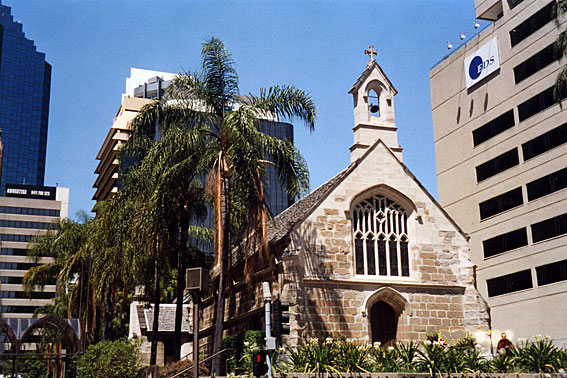
St Stephen's Old Cathedral (Pugin Chapel)
[Photograph by Geoffrey Cox (September 2007)]

St Stephen's Old Cathedral (Pugin Chapel)
[Photograph by Geoffrey Cox (September 2007)]
Historical and Technical Documentation by Geoffrey Cox
© OHTA 2007, 2011, 2013 (last updated January 2013)
Catholicism could be said to have first reached Queensland with the visit of Archbishop John Bede Polding from Sydney in May1843, only twelve months after the colony of Moreton Bay was opened for free settlement in 1842. Mass was at first celebrated in the old Government store in Elizabeth Street.1 Old St Stephen's Cathedral was constructed between 1848 and 1850, and is the oldest surviving church building in Queensland. The first mass in the building was celebrated on 12 May 1850, and it became the Cathedral in 1859 with the appointment of Bishop James Quinn to the newly proclaimed Diocese of Brisbane.2
This simple Gothic building was built to an 1842 design supplied to Archbishop Polding by the eminent English architect, Auguste Welby Pugin.3 It was the principal Catholic church in Brisbane until the new Cathedral was opened alongside it in May 1874.4
Because of the soft sandstone used in its construction, the original belfry had crumbled away even by the late 1860s, and the building has several times been threatened with demolition. It has been used variously as a school room, church offices and for storage over the period of a more than a century, and was restored in 1995-99 as a diocesan shrine of St Mary of the Cross (MacKillop).5

St Stephen's Old Cathedral (Pugin Chapel)
[Photograph by Simon Colvin (May 2008)]
First Organ.
A seraphine was used in this building from October 1850 onwards, by which time there was already a "very respectable and efficient choir" under the direction of Mr W.A. Duncan.6
The first pipe organ in this building was brought out from Europe by Bishop James Quinn, and first used in January 1873. It was moved to the new St Stephen's Cathedral in 1874.7
Present Organ.
The present organ in the Pugin Chapel originated as a small instrument constructed by George Fincham & Sons of Melbourne in the mid 1970s. It was one of at least four identical mobile chamber organs (on wheels) constructed by Finchams at the time. Others survive at the Charles Darwin University Performing Arts Centre, Darwin, and at the University of New South Wales Music Department, while another (originally at the Faculty of Music, University of Melbourne) is now at St Peter's Anglican Church, Eastern Hill, Melbourne. The chest and original keyboard were supplied by G. Hradetzky of Austria, while the pipework and original case were made by Finchams in Melbourne.8
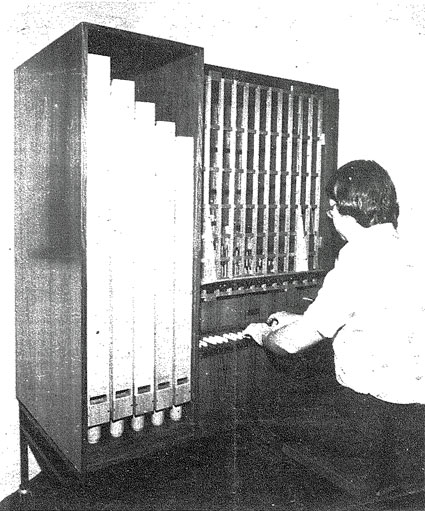
Mr David Molloy at the George Fincham & Sons organ
[Photograph: The Leader (25 June 1978), p. 15]
Mr David Molloy, then organist of St Stephen's Cathedral, Brisbane, had been impressed by the organ when attending the 1978 Festival of Organ and Harpsichord in Melbourne, and was instrumental in having it brought to Brisbane and purchased by the Liturgical Commission of the Archdiocese. It was initially hired by the Institute of Pastoral Liturgy in June/July 1978 for a ten-week course on liturgy being conducted at the Augustinian House of Studies, Clayfield.9 After being housed for a short time in 1978-79 in the Pugin Chapel (Old St Stephen's Cathedral), the instrument was moved by H.W. Jarrott in May 1979 to the Institute of Pastoral Liturgy (formerly Augustinian Priory) at Clayfield. It was purchased by Pius XII Seminary, Banyo, in June 198810
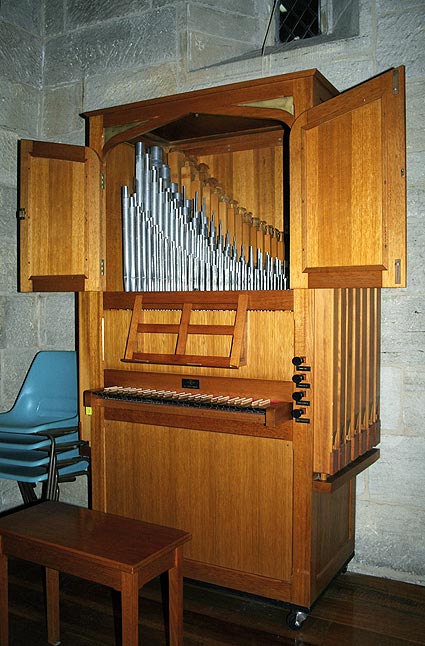
[Photograph by Trevor Bunning (October 2007)]
After being extensively rebuilt by W.J. Simon Pierce of Brisbane in 1998, the instrument was returned to the Pugin Chapel at some time following the rededication of the building on 5 February 1999. The casework was completely remade in Tasmanian Oak, the soundboard reduced, and new pallets, keyboard and suspended action were fitted. All pipework was re-scaled and revoiced, and much of the 8ft and 2ft ranks were completely replaced. Indeed, relatively little of the original instrument remains, and the resulting organ is essentially the work of W.J. Simon Pierce.11
| MANUAL Stopt Diapason Rohr Flute Principal Quint |
8 4 2 1-1/3 |
[originally 'Gedeckt'] (metal) |
Compass: 54 notes
Mechanical action
No pedals.12
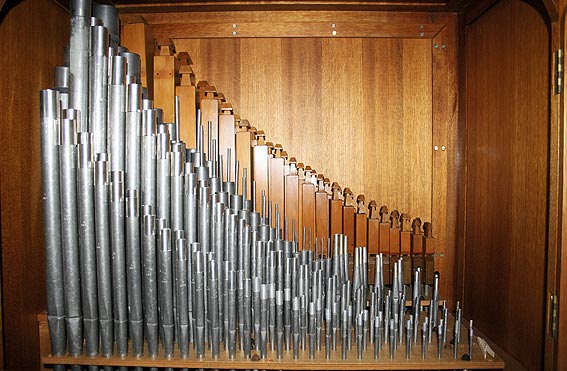
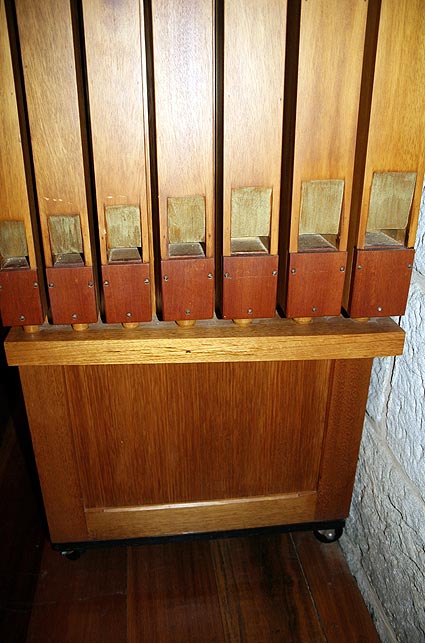
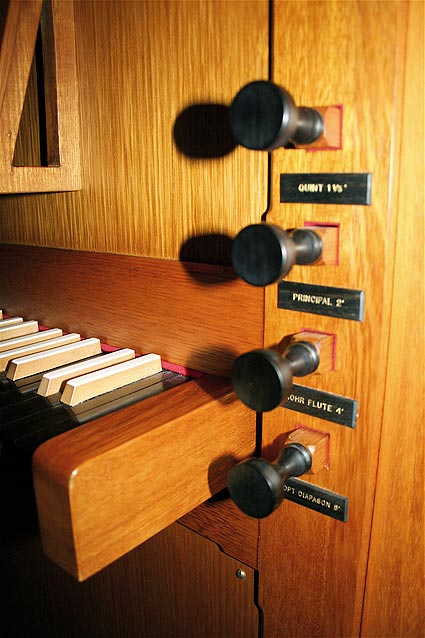

[Photographs by Trevor Bunning (October 2007)]
___________________________________________________________________________
1 Denis W. Martin, The Foundation of the Catholic Church in Queensland (Toowoomba: Church Archivists' Society, 1988), pp. 1, 12-13, 50.
2 Queensland Heritage Council, Queensland Heritage Register, location 600108; Liturgy News, vol. 29, no. 1 (March 1999), p. 10.
3 Brian Andrews, Australian Gothic: The Gothic Revival in Australian Architecture from the 1840s to the 1950s (Carlton South: Melbourne University Press, 2001), pp. 73, 151.
4 Pugh's Queensland Almanac for 1875, s.v. 16 & 17 May, 1874.
5 Liturgy News, vol. 29, no. 1 (March 1999), p. 10.
6 Martin, op. cit., p. 99.
7 The Brisbane Courier (24 January 1873), p. 4; The Freeman's Journal (8 February 1873), p. 6; The Brisbane Courier (16 May 1874), p. 1.
8 Personal communication to W.J. Simon Pierce from David Fincham (undated).
9 The Leader (25 June 1978), p. 15.
10 Personal communication to G. Cox from Veronica Corkeron, 4 July 1988; see also: Organ Society of Queensland Newsletter, vol. 15, no. 2 (October 1987), p. 10.
11 The Organ Voice, vol. 25, no. 2 (June 1999), p. 27.
12 Details supplied by W.J. Simon Pierce, September 2000; Original specification supplied by Veronica Corkeron, 4 July 1988.